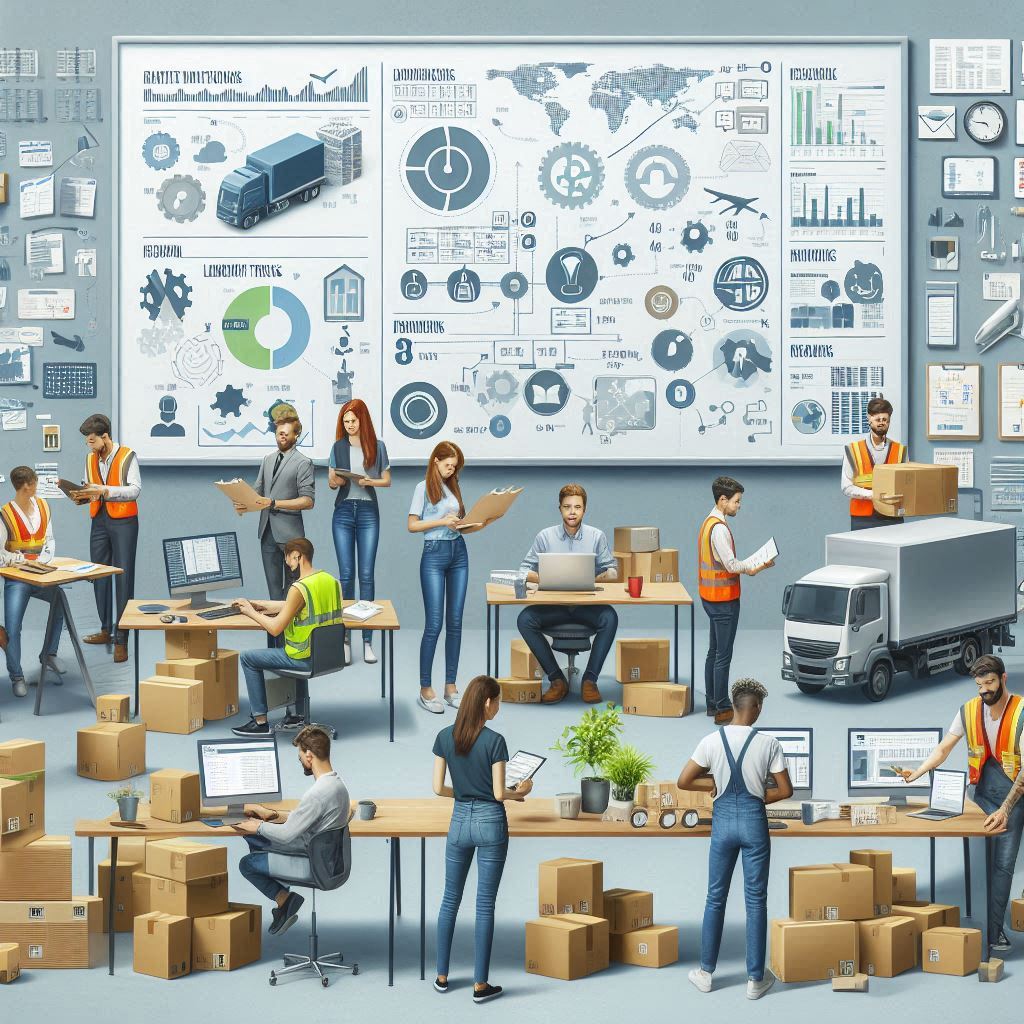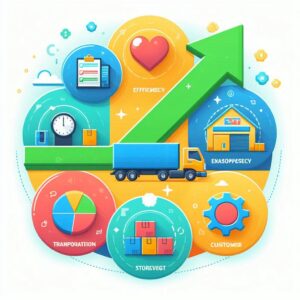Organizing logistics. It’s one of those words that sounds complex, but at its core, it’s all about making sure things get from one place to another in the right way, at the right time, and with as little hassle as possible. Whether you’re running a business, planning an event, or managing a large project, organizing logistics is a crucial part of ensuring everything runs smoothly. But don’t worry—organizing logistics doesn’t have to be overwhelming.
Logistics might sound like a complicated term, but it essentially refers to the process of planning, organizing, and managing the flow of goods, services, or information from one place to another. Whether you’re shipping products to customers, organizing an event, or planning a supply chain, logistics is a key part of getting things done smoothly.
What is Logistics?
In simple terms, logistics is all about moving things efficiently. It includes everything from the movement of raw materials to factories, delivery of finished goods to customers, or even managing the transportation of people or products. Effective logistics ensures that everything arrives at the right time, in the right condition, and at the right cost.
Subscribe to the Ex-works24/7 newsletter
The Key Steps in Organizing Logistics
-
Planning: The first step in organizing logistics is to plan. This is where you identify what needs to be delivered, where it’s going, when it should arrive, and what resources (like vehicles, workers, or tools) you’ll need. Good planning sets the foundation for everything that comes afterward.
- Tip: Create a detailed plan or checklist. Write down all the steps, resources, and deadlines, so nothing gets overlooked.
-
Choosing the Right Transportation: Whether it’s by land, sea, or air, choosing the right mode of transportation is critical. If you’re moving large quantities, trucks or ships may be the best option. For smaller, high-priority shipments, air transport might be more suitable.
- Tip: Factor in cost, delivery time, and the type of goods being transported when deciding on the best transportation method.
-
Inventory Management: You need to keep track of what you have and what you need. Poor inventory management can lead to delays, overstock, or stockouts. To stay organized, it’s essential to have a system to track inventory levels in real-time.
- Tip: Use inventory management software to automate tracking and get updates in real-time.
-
Warehousing and Storage: Before goods are shipped, they often need to be stored. Organizing your warehouse efficiently can save a lot of time when you need to pick and pack products quickly. Make sure items are categorized properly, with clear labels and easy-to-access shelving.
- Tip: Use the “first in, first out” (FIFO) system to ensure older products are used or shipped before newer ones, preventing spoilage or outdated stock.
-
Order Fulfillment: Once your goods are stored, the next step is order fulfillment. This means picking, packing, and shipping products based on customer orders. A streamlined fulfillment process ensures that products are shipped on time and in the right condition.
- Tip: Keep track of order status at every step to identify any issues early and make sure customers receive their products when promised.
-
Tracking and Delivery: After your goods are on their way, tracking is key. Knowing where shipments are at any given time helps ensure no unexpected delays. Tracking also gives you and your customers peace of mind, knowing everything is on schedule.
- Tip: Invest in tracking tools or software that can give you real-time updates on the location of shipments.
-
Feedback and Adjustment: After the delivery is completed, get feedback from your customers or team about what worked well and what didn’t. Logistics is always a work in progress, and small tweaks can help improve the process for next time.
- Tip: Use feedback to identify bottlenecks or inefficiencies and make adjustments accordingly.
Tools & Technology to Help Organizing Logistics
Logistics can be complex, but the good news is that technology has made organizing logistics much easier. Here are some tools and software that can help you stay on top of things:
Inventory Management Software: Tools like TradeGecko, Zoho Inventory, and QuickBooks Commerce can help you keep track of your stock levels, reorder products when needed, and automate inventory processes.
Shipping and Tracking Tools: Software like ShipBob, Shippo, and UPS My Choice allow you to track shipments, print labels, and get real-time updates on your deliveries.
Project Management Tools: Use platforms like Trello, Asana, or Monday.com to manage logistics tasks, create checklists, and assign responsibilities to team members.
Route Optimization Tools: Tools like Route4Me and Circuit can help you plan the most efficient delivery routes for your vehicles, saving both time and fuel.
Communication Tools: To ensure smooth coordination with suppliers, drivers, and customers, tools like Slack, Microsoft Teams, or even WhatsApp can keep everyone connected in real time.
Tips for Streamlining Logistics
Stay Organized: The more organized your logistics are, the smoother the whole process will run. Use digital tools to keep track of everything, from inventory to deliveries.
Work with Reliable Partners: Whether it’s a supplier, transportation company, or warehouse provider, working with trustworthy partners can make your logistics process a lot easier. Build strong relationships and communicate clearly.
Anticipate Problems: In logistics, problems will inevitably arise. Whether it’s a late delivery, a missing shipment, or a stock shortage, try to anticipate potential issues and have a backup plan in place.
Focus on Efficiency, Not Just Cost: While it’s important to keep logistics costs under control, don’t compromise on quality or speed. Inefficient logistics may save money in the short term, but they can hurt your business in the long run.
Evaluate and Improve: After completing each logistics task, take a moment to evaluate what went well and what didn’t. Identify areas for improvement and tweak your processes to make things more efficient next time.
In conclusion, logistics may seem like a huge and overwhelming task, but when you break it down into manageable steps, it becomes much more manageable. By planning ahead, using the right tools, and staying organized, you can ensure that goods and services move smoothly from one point to another. The goal is to make sure things arrive at the right place, at the right time, and at the right cost. With a little practice and the right systems in place, organizing logistics can become a streamlined process that helps your business or project succeed.
Frequently
Asked Questions
Logistics management involves coordinating the movement of goods and services from the point of origin to the final consumer. The key components include:
- Transportation: Selecting and managing the most cost-effective and timely method for moving goods.
- Warehousing: Storing goods safely and organizing them efficiently to ensure quick retrieval.
- Inventory Management: Monitoring stock levels, predicting demand, and ensuring that goods are available when needed.
- Order Fulfillment: The process of picking, packing, and shipping products to customers.
- Supply Chain Coordination: Aligning and communicating with suppliers, distributors, and other stakeholders to optimize the flow of goods.
Some common challenges in logistics include:
- Supply Chain Disruptions: External factors like weather, strikes, or geopolitical events can disrupt the flow of goods.
- Rising Costs: Fluctuations in fuel prices, labor costs, and tariffs can make logistics more expensive.
- Demand Fluctuations: Variability in customer demand can result in overstocking or stockouts, both of which impact operational efficiency.
- Inventory Management: Maintaining the right balance between too much stock (leading to high holding costs) and too little (leading to missed sales).
- Complex Regulations: Compliance with international trade laws, safety standards, and environmental regulations can complicate logistics planning.
Technology plays a crucial role in streamlining logistics operations:
- Automation: Using software and robots to handle repetitive tasks like inventory management and order fulfillment.
- Tracking and Visibility: GPS tracking, RFID, and IoT devices help monitor shipments in real time, improving transparency and reducing delays.
- Data Analytics: Analyzing trends and customer data to forecast demand, optimize routes, and reduce costs.
- Warehouse Management Systems (WMS): Software that helps organize storage, track inventory, and improve picking and packing efficiency.
- Cloud-based Solutions: Allowing real-time collaboration, data sharing, and inventory management across global operations.
Outsourcing logistics can offer several advantages:
- Cost Savings: Outsourcing to third-party logistics (3PL) providers can reduce overhead costs related to infrastructure, transportation, and labor.
- Expertise: 3PLs have specialized knowledge and experience in managing logistics operations, allowing businesses to focus on core activities.
- Scalability: Logistics providers can scale operations quickly to meet changing demands, such as seasonal spikes.
- Improved Efficiency: Providers often use advanced technology and streamlined processes to deliver faster and more accurate service.
- Risk Management: Outsourcing can help mitigate risks related to supply chain disruptions and compliance by leveraging the expertise of logistics specialists.
To improve customer satisfaction through logistics, businesses can:
- Ensure Timely Deliveries: Meeting delivery promises is key. Optimizing routes and using reliable shipping methods can help minimize delays.
- Provide Real-time Tracking: Offering customers the ability to track their orders gives them confidence and reduces inquiries about shipment status.
- Improve Order Accuracy: Streamlining inventory management and order fulfillment processes helps reduce errors in shipments.
- Flexible Delivery Options: Offering various delivery methods (e.g., express, same-day, or pick-up options) can increase customer satisfaction by catering to their preferences.
- Effective Communication: Keeping customers informed about their order status, including any delays or changes, fosters trust and transparency.




